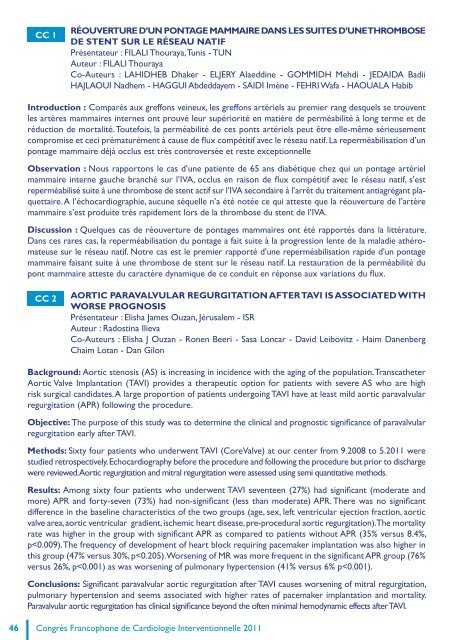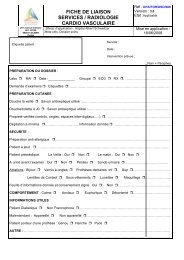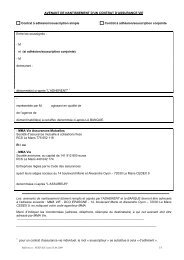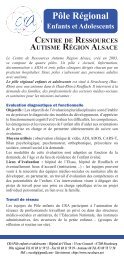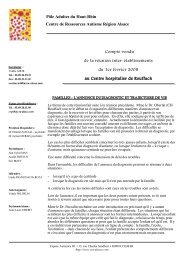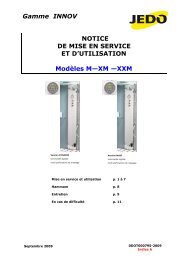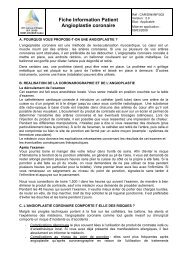Francophone - Webagoo.eu
Francophone - Webagoo.eu
Francophone - Webagoo.eu
You also want an ePaper? Increase the reach of your titles
YUMPU automatically turns print PDFs into web optimized ePapers that Google loves.
CC 1<br />
RÉOUVERTURE D’UN PONTAGE MAMMAIRE DANS LES SUITES D’UNE THROMBOSE<br />
DE STENT SUR LE RÉSEAU NATIF<br />
Présentat<strong>eu</strong>r : FILALI Thouraya, Tunis - TUN<br />
Aut<strong>eu</strong>r : FILALI Thouraya<br />
Co-Aut<strong>eu</strong>rs : LAHIDHEB Dhaker - ELJERY Alaeddine - GOMMIDH Mehdi - JEDAIDA Badii<br />
HAJLAOUI Nadhem - HAGGUI Abdeddayem - SAIDI Imène - FEHRI Wafa - HAOUALA Habib<br />
Introduction : Comparés aux greffons vein<strong>eu</strong>x, les greffons artériels au premier rang desquels se trouvent<br />
les artères mammaires internes ont prouvé l<strong>eu</strong>r supériorité en matière de perméabilité à long terme et de<br />
réduction de mortalité. Toutefois, la perméabilité de ces ponts artériels p<strong>eu</strong>t être elle-même séri<strong>eu</strong>sement<br />
compromise et ceci prématurément à cause de flux compétitif avec le réseau natif. La reperméabilisation d’un<br />
pontage mammaire déjà occlus est très controversée et reste exceptionnelle<br />
Observation : Nous rapportons le cas d’une patiente de 65 ans diabétique chez qui un pontage artériel<br />
mammaire interne gauche branché sur l’IVA, occlus en raison de flux compétitif avec le réseau natif, s’est<br />
reperméabilisé suite à une thrombose de stent actif sur l’IVA secondaire à l’arrêt du traitement antiagrégant plaquettaire.<br />
A l’échocardiographie, aucune séquelle n’a été notée ce qui atteste que la réouverture de l’artère<br />
mammaire s’est produite très rapidement lors de la thrombose du stent de l’IVA.<br />
Discussion : Quelques cas de réouverture de pontages mammaires ont été rapportés dans la littérature.<br />
Dans ces rares cas, la reperméabilisation du pontage a fait suite à la progression lente de la maladie athéromat<strong>eu</strong>se<br />
sur le réseau natif. Notre cas est le premier rapporté d’une reperméabilisation rapide d’un pontage<br />
mammaire faisant suite à une thrombose de stent sur le réseau natif. La restauration de la perméabilité du<br />
pont mammaire atteste du caractère dynamique de ce conduit en réponse aux variations du flux.<br />
CC 2<br />
AORTIC PARAVALVULAR REGURGITATION AFTER TAVI IS ASSOCIATED WITH<br />
WORSE PROGNOSIS<br />
Présentat<strong>eu</strong>r : Elisha James Ouzan, Jérusalem - ISR<br />
Aut<strong>eu</strong>r : Radostina Ilieva<br />
Co-Aut<strong>eu</strong>rs : Elisha J Ouzan - Ronen Beeri - Sasa Loncar - David Leibovitz - Haim Danenberg<br />
Chaim Lotan - Dan Gilon<br />
Background: Aortic stenosis (AS) is increasing in incidence with the aging of the population. Transcatheter<br />
Aortic Valve Implantation (TAVI) provides a therap<strong>eu</strong>tic option for patients with severe AS who are high<br />
risk surgical candidates. A large proportion of patients undergoing TAVI have at least mild aortic paravalvular<br />
regurgitation (APR) following the procedure.<br />
Objective: The purpose of this study was to determine the clinical and prognostic significance of paravalvular<br />
regurgitation early after TAVI.<br />
Methods: Sixty four patients who underwent TAVI (CoreValve) at our center from 9.2008 to 5.2011 were<br />
studied retrospectively. Echocardiography before the procedure and following the procedure but prior to discharge<br />
were reviewed. Aortic regurgitation and mitral regurgitation were assessed using semi quantitative methods.<br />
Results: Among sixty four patients who underwent TAVI seventeen (27%) had significant (moderate and<br />
more) APR and forty-seven (73%) had non-significant (less than moderate) APR. There was no significant<br />
difference in the baseline characteristics of the two groups (age, sex, left ventricular ejection fraction, aortic<br />
valve area, aortic ventricular gradient, ischemic heart disease, pre-procedural aortic regurgitation). The mortality<br />
rate was higher in the group with significant APR as compared to patients without APR (35% versus 8.4%,<br />
p


